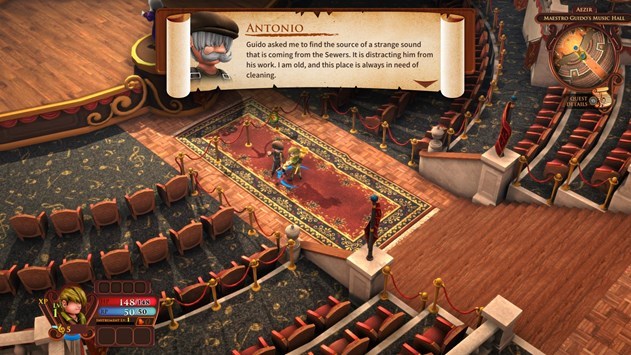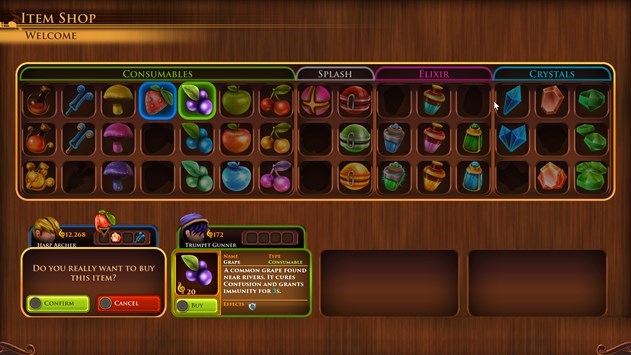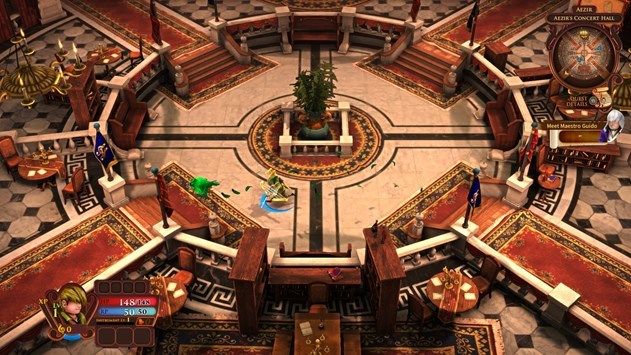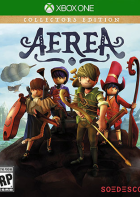AereA is available on Steam for $29.99 And on Xbox one for $39.99 and on PS4 for $59.99
STORY
The world of AereA is powered by music, though you wouldn’t know it if they didn’t tell you directly. Years ago, the world of AereA was fractured into four islands due to the misuse of the magic of music. Only through the use of nine Primordial Instruments were the islands able to stay aloft in the sky. Now the instruments have gone missing, and it’s up to a student at a school for musicians (maybe) to track them down and restore them to their proper places.
It’s actually unclear what you’re a stupid of, other than music in general. Though the concert hall that acts as your school is large, it’s largely uninhabited. The game tells you to seek out other students to receive side quests, but there is literally only one other student in the entire school. Your training appears to have been in musical combat, though considering the relative peace you enjoy before things go awry, why they need musical combatants is a mystery.

As you progress, you learn more about the history of the musical world and how it came to the state it is when you begin your adventure. Unfortunately, if you were expecting to hear about how music is cleverly used in substitute for everyday things, you’ll be disappointed. Music is regarded as a powerful magic, something that binds and controls everything in the world, but the only utilization seems to be keeping islands up in the sky and combat. There’s nothing interesting done with the idea of a world powered by music. The hero classes are barely even related to music, if using instruments as weapons even qualifies.
Overall don’t expect much from the plot of the game. There’s a catastrophe that they school is trying to keep quiet and employs you to find the eight magical MacGuffins, defeat the evil guy, and restore balance. It’s told in pieces between quests, rather than during the quests themselves. By separating the story from the gameplay, it feels like you are playing sections to unlock chapters in a book, rather than playing through those chapters and experiencing a nice narrative flow.
GAMEPLAY
As stated before, AereA is an isometric action RPG. This means you’ll be controlling your hero from a top down perspective, hacking and slashing your way through enemies, leading up to an ultimate goal of a boss. Several times during that description I wanted to mention getting loot, as that’s a main driving force behind games in this genre, but I had to remind myself there is no loot in this game. You pick up currency and items, but the former just goes to buying more of the latter, as well as upgrading special attacks.
Now it’s not fair to grade a game on what it doesn’t have, assuming it made no promises that it would. Having a loot system is a welcomed addition to the genre, but it’s not a necessity to make the game playable. However, much of the thrill, at least for me, of playing these kinds of games is getting new weapons and gear from the endless enemies you’ll be facing. The act of combat, on its own, is fine, of course – assuming the combat is actually fun.
Combat in AereA consists of a few buttons. You have your main attack, a secondary attack (a melee strike if you’re ranged and a shield block if you’re melee focused), a special attack, and your items. In other isometric action RPGs, you would have a skill bar, consisting of all the spells and abilities you can utilize together or separately to deal with anything from simple to problematic situations. AereA simplifies combat considerably, to a fault. There’s a repetitiveness that can occur in the genre, mashing your way through endless enemies, but the reward is either the fun of using different abilities or loot. When combat is simply hitting one button or the other, and it’s all toward the goal of leveling up or opening a door, the fun incentive vanishes.

More concerning about the combat is how stupidly easy it is. From dungeon one, I was able to dispatch enemies in one hit. No big deal, I thought. These are sewer rats, typical RPG fodder that aren’t supposed to pose a challenge, just help you learn the ropes. Sadly, that godlike strength would never leave my side. Every enemy, and I mean every single one, excluding bosses, can be killed in one hit. Just one. Be it a rat, or a scorpion, or a buzzard, or a swamp lizard, or even any of the larger, differently colored, versions of the aforementioned monsters can be killed in just one hit. I see now why Saitama finds extreme boredom in being able to defeat any monster in just one punch.
My theory is this is a result of an imbalance in the game’s design. Likely, the experience and leveling system was balanced around four players playing at once. Experience would be earned per the individual, rather than given in equal portions to all. This would result in the player leveling up at a much slower rate than if they played solo, like I did. Yet, this wouldn’t account for everything. In the middle of your campaign, you can swap to a different hero. This hero wouldn’t have any of the progress in leveling that your previous one did; only sharing progress in the story. After defeating two bosses, counting for roughly six maps, I swapped in a different hero, level 1 to my main hero’s level 10, to see how he would fair. The newbie warrior of course didn’t do as much damage, and yet was still able to defeat monsters with considerable ease. I couldn’t test out the multiplayer, as the mode is local only. It’s nice to see local multiplayer still supported in our online age, but not when it’s the only option available. Another possibility is the imbalance stems from some percentages being too high when upgrading an instrument’s attack power. Even distribution of points after the fact didn’t help matters, unfortunately.
Speaking of the heroes, there are four to choose from: cello knight, harp archer, lute magic, and trumpet gunner. All except cello knight are ranged classes. As you probably guessed from the names, each class utilizes a different instrument as their weapon. For example, the warrior plays the cello, wielding the cello itself as a shield and the stick as his sword. This is a cute idea, and is the kind of thing I was hoping to see more of in a game where music was (supposedly) everything. There’s a downside to using an instrument for a weapon, unfortunately: the noise. Every attack is accompanied by a blast of a trumpet or a slap across the strings. It doesn’t sound musical, it sounds noisy, and it only serves to drown out the actual music playing in the background. Imagine a recording of an orchestra is playing, and over it is a 3rd grade class doing their best not to break their rentals as they slam their sticky fingers against the strings.

Levels are divided up by ecosystems. You’ll be exploring swamps, deserts, ruins, all the RPG staples. After two maps, you’ll go up against a boss. Now the boss itself doesn’t get its own map. Instead, after you complete the second map, you are then asked to go back to the second map, do it all over again, and this time go through the boss door. This groan-inducing retreading is a constant problem, not just when going up against a boss.
All of the levels are littered with locked doors. Some of them need a lever to be pulled, others need a block to be pushed, and the rest only open when surrounding enemies are defeating. Of these methods, only the monster slaughter makes sense to what door it opens. When a lever is pulled or a block is pushed into a slot, a seemingly random door, possibly all across the map, back through already cleared spots, will open. You had better pay attention to where the camera directs you, too. Though you have a mini-map, you don’t have a full sized map. So retracing your steps can prove difficult if you get side tracked.
The only reasons to get sidetracked, however, are your eyes glazing over from boredom or doing a side quest, and the latter isn’t likely. All side quests, and I mean all of them, consist of gathering materials or killing a certain number of enemies. The kid you get these quests from is never satisfied. Killed six rats? Now go kill eight birds. Killed those birds? Now go kill 10 whatevers, and it continues on like this, increasing at a predictable rate, and always trying to get you to go back to previous maps. The rewards are never worth it, either, so do yourself a favor and don’t bother with them (assuming you absolutely have to play this game).

There were almost no bugs to speak of in this game, and it performed well, with only one moment of framerate loss. However, the one and only bug that did pop up caused me to give up on the game completely. Part way through the swamp, I ran into two lizard men who would only take 1 damage from each of my attacks. Up until that point, all the other lizard men died in one hit, just like everything else. There was nothing special about these enemies that would lead me to believe they were designed to be extra tough. They were just part of a larger pack of enemies that had to die in order for a door to open. Still, I managed to kill them both, and moved on. And then, I reached the concert hall.
The concert hall was by far the longest and yet somehow the most empty dungeon up until that point. Countless locked doors, all opened by levers and blocks found on the other end of the map, with rooms sparsely populated with rats and bats you would find in the first level. At the end of the 30 minute slog, I came upon the boss. Wouldn’t you know it, the bug reared its ugly head, and the boss would only take 1 damage a hit. This I couldn’t brute force, and ended up dying. It being my first death, I didn’t know what I was in for. Rather than restart outside the room, I was forced all the way back to the start of the dungeon, and that’s when I refused to keep playing.
I say this because I want to be honest with how much of the game I completed. If each instrument takes the same amount of time to collect, I’d say I did half of the content, and can say with conviction that the game showed no evidence of radically improving if I kept going. Whether or not you feel this invalidates this review is your choice, but I assure you I have no reason to lie about this bug occurring, and even if it hadn’t my complaints about the game overall would be the same.
GRAPHICS/AUDIO
Something that AereA does fine and great is the graphics and music, respectively. Graphically everything looks cute and cartoonish. All the characters are designed with bangs that cover their eyes, a design I hadn’t seen before and found to be charming. The enemy designs were clear enough that they didn’t blend in with the environments, which were well designed (even if the level design was abysmal).

The music was, thankfully, very good. In a game about music, if the tracks were bad, the whole thing would be a wash. Though some songs felt derivative of movie soundtracks, like Star Wars, they were still well done and added some nice atmosphere. Sadly, the music is very hard to hear over the constant sound of your hero strumming and blasting their weapons nonstop. It became tempting to just turn off the sound effects and just listen to the music.
CONCLUSION
The simplified combat, easy controls, low-challenge, and pleasing graphics make this game a good introduction for a child into the genre of isometric RPGs, but even then I’d still recommend Torchlight, if not Diablo II. There’s really no market I can see that would consistently enjoy this watered down, uninspired, drip of a game. Even as a mindless hack and slash this game fails in every aspect. Under no circumstances should you, or your friends, subject themselves to this game when so many better options exist. If you want a fun isometric RPG, consider the games already mentioned. If you want a game where music is ingrained with the gameplay, try Crypt of the Necrodancer or Metronomicon (a game I can’t recommend enough, seriously go play it).

The worst part is there is potential with the idea behind this game. It didn’t need a loot system, but it would have benefited greatly from one. What it needed was some more care beyond the bare essentials. It needed life, spirit, and original thought. There seems to be a good idea behind this game, a pitch I can picture that would have gotten me excited to play it. For whatever reason, we got something bland and boring, and the worst thing a game can be is forgettable. When a game is great, it succeeded. When a game is terrible, it failed. In both situations, a risk was taken. When a game is boring, it feels like the only interest in it being made was to make money. I hope I’m not wrong, and this game was actually made by a dedicated team of passionate individuals, because if that’s the case that is extremely depressing.
| PROS |
CONS |
| + Charming art style. |
– Dull and tedious combat. |
| + Exciting and enjoyable musical score. |
– Horrible stat imbalance resulting in “god mode.” |
|
– Terrible level design. |
|
– Weapon attack sounds are very annoying. |











